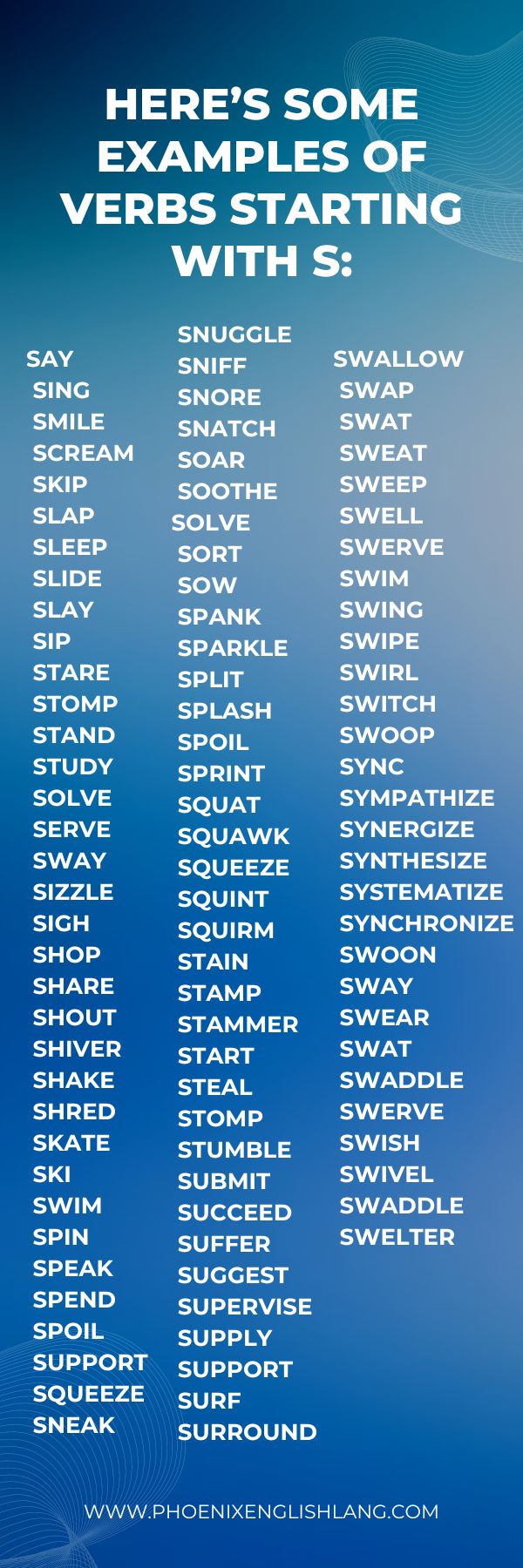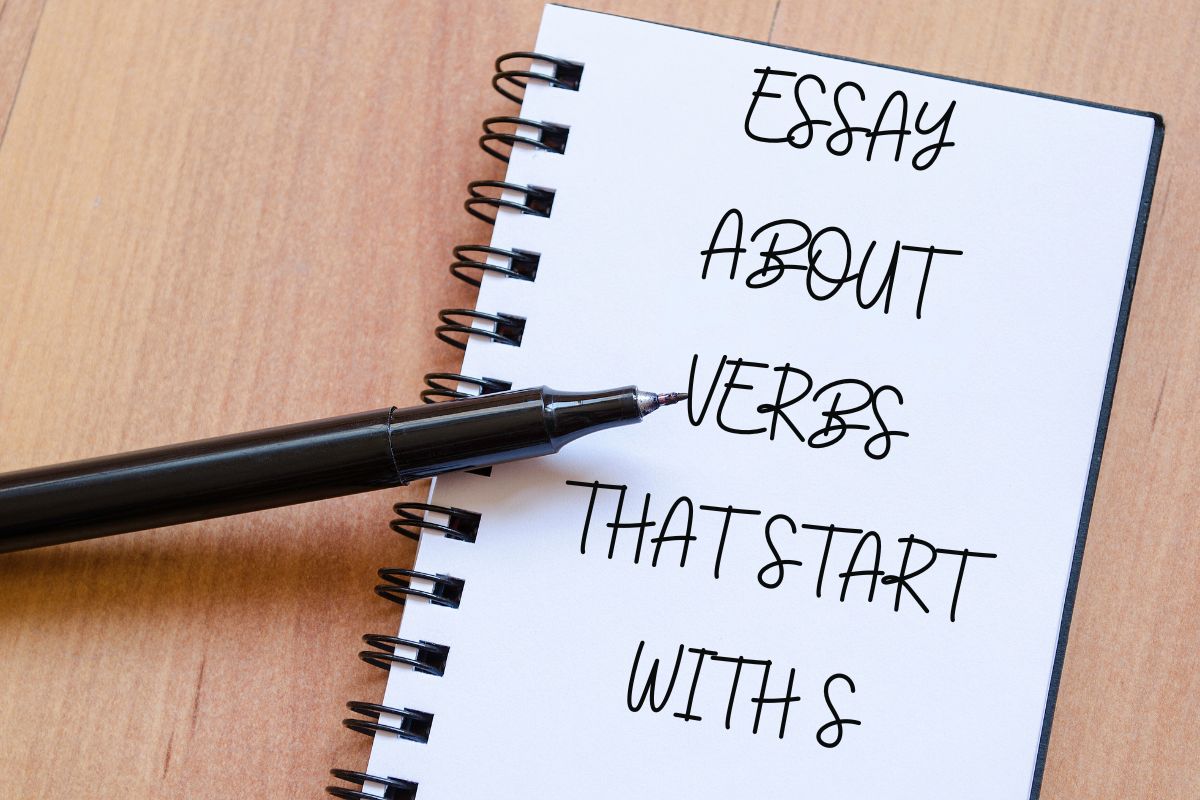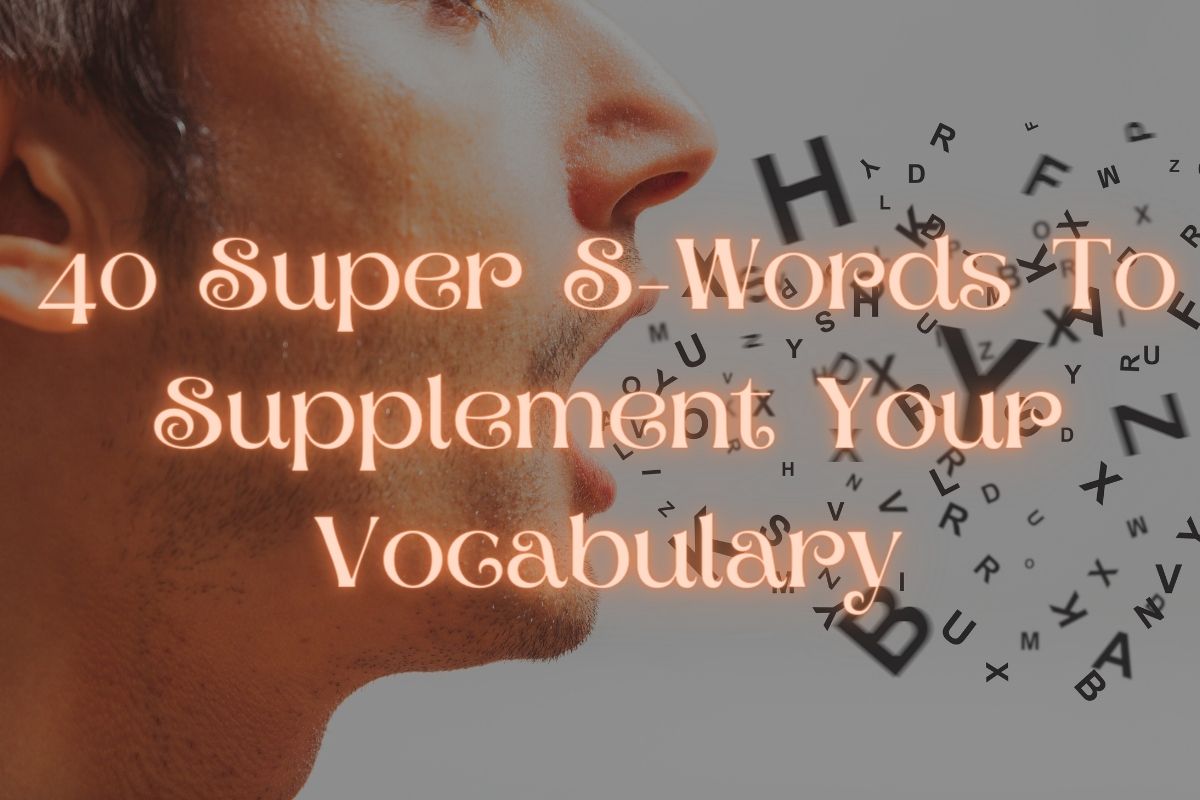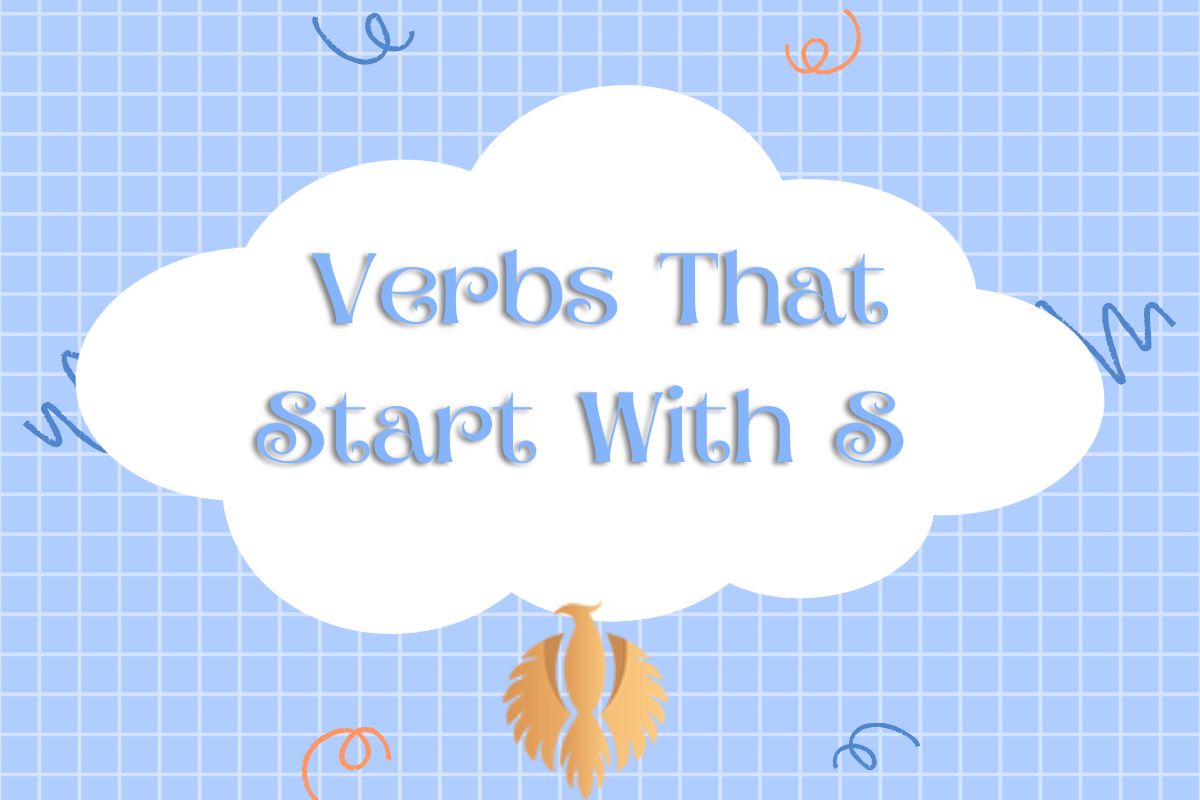Hello everyone! Are you ready to embark on an exhilarating adventure into the world of verbs that start with ‘S’?
In today’s lesson, we’ll dive into the vibrant and dynamic realm of ‘s’ verbs. To kick things off, let’s play an exciting game of verb charades!
I’ll start by sharing the top 100 commonly used verbs that start with ‘s,’ and your mission is to come up with even more examples beyond what I provide. Who’s eager to jump in?
Fantastic! Let’s get started. Verbs are the action heroes of our sentences, bringing energy and life to our language. They show us what actions someone or something is taking.
Today, we’re shining a spotlight on verbs that begin with the letter ‘s.’ This letter is special because it leads to so many lively and fascinating verbs.
From straightforward actions like ‘sit’ and ‘stand’ to more intricate ones like ‘synthesize’ and ‘strategize,’ ‘s’ verbs are all around us!
Let’s kick off with a fun game of verb charades! I’ll act out a verb that begins with the letter ‘s,’ and your job is to guess what it is. For instance, if I mimic sleeping, you will guess the verb ‘sleep.’ If I pretend to swim, you’d say ‘swim.’
It’s a fantastic way to get everyone thinking about the various verbs we use daily.
Now, let’s consider the magic of verbs. Without them, our sentences would be dull and lifeless.
Just imagine trying to tell a story without any action words! Verbs allow us to convey what’s happening, whether it’s something occurring now, something we did before, or something we plan to do later.
They are essential for effective and lively communication.
As we explore these ‘s’ verbs, I encourage you to think about how you use them in your daily life. Do you ‘study’ for exams? Do you enjoy ‘singing’ in the shower? Perhaps you ‘skate’ at the park or ‘shop’ with friends.
Verbs are everywhere, helping us express ourselves in countless ways.
Let’s take a moment to brainstorm some verbs that begin with the letter ‘s.’ I’ll start with a few examples: ‘sail,’ ‘search,’ ‘shout,’ and ‘smile.’ Can you come up with anymore? Perhaps ‘solve,’ ‘sprint,’ or ‘support’? The possibilities are endless!
As we dive into this lesson, I encourage you to jot down any new verbs you encounter. Try incorporating them into your sentences and see how they can add detail and excitement to your writing.
For example, instead of saying “I walked to the store,” you might say “I strolled to the store” or “I sprinted to the store.” Notice how the choice of verb changes the tone of the sentence?
We’ll also explore some more complex verbs that start with ‘s.’ For instance, ‘synthesize,’ which means merging various ideas into a unified whole, or ‘strategize,’ meaning to devise a plan of action.
Using these verbs can elevate your writing and speaking, making them sound more polished and precise.
By the end of this lesson, you’ll gain a fresh appreciation for the power of verbs, especially those that start with ‘s.’
You’ll discover how they can transform your sentences, making your communication more vibrant and engaging.
So, who’s excited to embark on this verb journey? Let’s jump in and see how many ‘s’ verbs we can uncover together!
Here’s some examples of verbs starting with S:

- Say
- Sing
- Smile
- Scream
- Skip
- Slap
- Sleep
- Slide
- Slay
- Sip
- Stare
- Stomp
- Stand
- Study
- Solve
- Serve
- Sway
- Sizzle
- Sigh
- Shop
- Share
- Shout
- Shiver
- Shake
- Shred
- Skate
- Ski
- Swim
- Spin
- Speak
- Spend
- Spoil
- Support
- Squeeze
- Sneak
- Snuggle
- Sniff
- Snore
- Snatch
- Soar
- Soothe
- Solve
- Sort
- Sow
- Spank
- Sparkle
- Split
- Splash
- Spoil
- Sprint
- Squat
- Squawk
- Squeeze
- Squint
- Squirm
- Stain
- Stamp
- Stammer
- Start
- Steal
- Stomp
- Stumble
- Submit
- Succeed
- Suffer
- Suggest
- Supervise
- Supply
- Support
- Surf
- Surround
- Swallow
- Swap
- Swat
- Sweat
- Sweep
- Swell
- Swerve
- Swim
- Swing
- Swipe
- Swirl
- Switch
- Swoop
- Sync
- Sympathize
- Synergize
- Synthesize
- Systematize
- Synchronize
- Swoon
- Sway
- Swear
- Swat
- Swaddle
- Swerve
- Swish
- Swivel
- Swaddle
- Swelter
Essay about verbs that start with s

Verbs are an essential part of language, providing the action and movement that give life to our words. There are numerous verbs that start with the letter “s,” each with its own unique meaning and impact on communication.
In this essay, we will explore the significance of verbs that start with “s” and their role in language and expression.
First and foremost, verbs that start with “s” are incredibly diverse, encompassing a wide range of actions and states of being.
From simple actions such as “sit” and “stand” to more complex processes like “synthesize” and “systematize,” these verbs play a crucial role in conveying meaning and intention in our speech and writing.
They allow us to describe physical movements, mental processes, and emotional states, providing a rich and nuanced vocabulary for communication.
One of the most notable aspects of verbs that start with “s” is their versatility. These verbs can be used to express a variety of actions and concepts, making them indispensable in everyday language.
For example, verbs like “speak,” “sing,” and “shout” allow us to convey different levels of vocal expression, while verbs like “swim,” “sprint,” and “stroll” describe various forms of physical movement.
Additionally, verbs such as “seek,” “strive,” and “succeed” capture the essence of aspiration and achievement, highlighting the emotional and motivational aspects of human experience.
Furthermore, verbs that start with “s” often carry a sense of dynamism and energy, reflecting the vibrancy and vitality of human existence.
Whether it’s the swift action of “sprint” or the steady progression of “sow,” these verbs capture the essence of movement and change, bringing life and momentum to our language.
They allow us to describe the world around us and our interactions with it, providing a means to express our experiences and perceptions in vivid detail.
In addition to their linguistic significance, verbs that start with “s” also have a profound impact on the rhythm and flow of language.
When used effectively, these verbs can create a sense of cadence and musicality in speech and writing, enhancing the overall impact and resonance of our communication.
Whether it’s the soft sound of “sigh” or the sharpness of “slash,” these verbs contribute to the auditory texture and aesthetic appeal of language, adding depth and dimension to our expression.
In conclusion, verbs that start with “s” are an integral part of language, offering a rich and diverse array of actions and concepts for communication.
Their versatility, dynamism, and impact on rhythm make them an essential component of speech and writing, enabling us to convey meaning, emotion, and experience in a nuanced and evocative manner.
As we continue to explore and expand our vocabulary, verbs that start with “s” will undoubtedly remain a fundamental and vibrant part of our linguistic repertoire.
You might also enjoy: How To Start Spoken English For Beginners? 7 Tips
What are some examples of verbs that start with “s” that you find particularly interesting or impactful?

Here are some examples of verbs that start with “s” that I find particularly interesting and impactful:
- Synchronize: This verb conveys the idea of coordinating or aligning different elements in time, creating a sense of harmony and unity. It’s often used in the context of music, technology, or teamwork.
- Sympathize: This verb represents the act of showing compassion or understanding towards someone’s feelings or experiences. It reflects empathy and emotional connection, highlighting the importance of human connection and support.
- Stimulate: This verb signifies the action of encouraging or inciting activity or growth. It conveys the idea of energizing or inspiring, whether it’s in a physical, mental, or emotional context.
- Strategize: This verb captures the process of planning or formulating a strategy, reflecting the deliberate and thoughtful approach to achieving a particular goal or outcome.
- Savor: This verb represents the act of enjoying or appreciating something deeply, often related to the senses or experiences. It conveys the idea of relishing and cherishing moments or sensations.
- Substantiate: This verb denotes the action of providing evidence or proof to support a claim or argument. It reflects the process of validating or confirming the validity of something.
- Surrender: This verb signifies the act of yielding or relinquishing control, power, or possessions. It conveys the idea of acceptance or submission, often in the context of conflict or struggle.
- Serenade: This verb represents the act of singing or performing music to someone as a gesture of affection or admiration. It conveys a sense of romantic expression and emotional connection.
- Stammer: This verb reflects the act of speaking with hesitancy or repetition, often due to nervousness or uncertainty. It conveys vulnerability and human imperfection.
- Stargaze: This verb signifies the act of gazing at the stars, reflecting a sense of wonder, curiosity, and contemplation of the universe.
These verbs offer a glimpse into the diverse and impactful nature of language, showcasing the range of actions, emotions, and experiences that can be expressed through verbs that start with “s.”
You might also enjoy: Top 100 Commonly Used Verbs That Start With E [2024]
Can you elaborate on how the verb “synchronize” can be applied in different contexts, such as music, technology, or teamwork?

The verb “synchronize” has a broad range of applications across various contexts, including music, technology, and teamwork. Here’s how the verb can be applied in each of these contexts:
- Music:
In the context of music, “synchronize” refers to the process of aligning different musical elements, such as beats, rhythms, or melodies, to create a harmonious and unified sound.
This can involve coordinating the timing of multiple instruments or voices in a musical ensemble, ensuring that they play or sing together in perfect unison.
Additionally, in electronic music production, synchronization often involves aligning different tracks and audio elements to create a cohesive and well-timed composition.
- Technology:
In the realm of technology, “synchronize” is often used to describe the process of ensuring that different devices, systems, or data sets operate in coordination with one another.
For example, in the context of file synchronization, it refers to the act of updating and aligning files across multiple devices or platforms to maintain consistency.
In the field of digital communication, synchronization is crucial for ensuring that electronic devices and networks are in harmony, allowing for seamless data transfer and interaction.
- Teamwork:
In the context of teamwork, “synchronize” pertains to the coordination and alignment of efforts among team members to achieve a common goal.
This involves ensuring that individuals work together in a synchronized manner, whether it’s in terms of timing, tasks, or objectives.
Effective synchronization in teamwork can lead to enhanced productivity, efficient collaboration, and the ability to achieve complex tasks in unison. It also fosters a sense of cohesion and unity within the team.
In all these contexts, the concept of “synchronize” emphasizes the importance of coordination, alignment, and harmony.
Whether it’s in the realm of music, technology, or teamwork, the verb “synchronize” underscores the value of achieving unity and coherence, ultimately leading to improved performance, efficiency, and effectiveness within each domain.
You might also enjoy: Top 100 Commonly Used Verbs That Start With R [2024]
Can you provide examples of how synchronization is crucial in digital communication within the technology context?

Synchronization plays a crucial role in digital communication within the technology context, particularly in ensuring seamless and efficient data transfer, as well as the coordination of devices and systems.
Here are some examples of how synchronization is essential in digital communication:
- Network Synchronization:
In digital communication, network synchronization is vital for ensuring that various devices and systems connected to a network operate in coordination with one another.
For example, in telecommunications, synchronization is crucial for maintaining the timing and frequency accuracy of signals across different network elements, such as base stations, routers, and switches. This ensures that data packets are transmitted and received in a synchronized manner, preventing errors, delays, or data loss.
- Multimedia Streaming:
In the context of multimedia streaming, synchronization is essential for delivering audio and video content seamlessly over digital networks.
For instance, in video conferencing or online streaming services, synchronization ensures that audio and video streams remain aligned and coordinated, preventing issues such as audio lag or video buffering. This synchronization is critical for providing a smooth and high-quality user experience.
- Data Synchronization:
Data synchronization is important for maintaining consistency and coherence across different databases, servers, and devices.
For example, in cloud computing, synchronization ensures that changes made to data in one location are reflected in all other synchronized locations, allowing for real-time access to updated information. This is crucial for collaborative work environments and remote access to data.
- Device Synchronization:
In the context of mobile and IoT (Internet of Things) devices, synchronization is essential for coordinating actions and data exchange between interconnected devices.
For instance, synchronization enables seamless integration between smartphones, smart home devices, and wearable technology, allowing for the exchange of information and commands in a synchronized and efficient manner.
- Time Synchronization:
Time synchronization is critical for ensuring that devices and systems operate with accurate and consistent timing.
For example, in financial transactions, network security, and distributed computing, precise time synchronization is essential for maintaining the integrity of data and preventing issues related to inconsistencies in timestamps and event sequencing.
In all these examples, synchronization in digital communication within the technology context is fundamental for maintaining the reliability, efficiency, and integrity of data transfer and interaction.
It ensures that devices, systems, and data remain aligned and coordinated, ultimately contributing to the seamless functioning of digital communication networks and services.
How do verbs that start with s Contribute to creating a sense of rhythm and flow in language?
Verbs that start with “s” can contribute to creating a sense of rhythm and flow in language by adding alliteration, creating a smooth and seamless transition between words, and establishing a consistent pattern of sound. When used effectively, these verbs can enhance the overall musicality and coherence of a piece of writing or speech. Additionally, verbs that start with “s” often have a soft and soothing sound, which can help to create a sense of harmony and fluidity in the language.
What are supportive words that start with S?
Some supportive words that start with the letter “S” include:
- Support
- Strength
- Sympathy
- Sincere
- Sustain
- Solidarity
- Security
- Shelter
- Encourage
- Empathy
These words can be used to provide comfort, encouragement, and reassurance to others in times of need. They convey a sense of understanding, compassion, and solidarity, helping to create a positive and supportive environment.
What is a caring word that starts with s?
A caring word that starts with “S” is “Support.” Support implies being there for someone in times of need, offering assistance, encouragement, and understanding.
It conveys a sense of care, compassion, and willingness to help others navigate challenges or difficult situations. Support is a powerful and caring word that can make a significant difference in someone’s life.
How can verbals help create a sense of rhythm in a poem?
Verbals, such as gerunds, participles, and infinitives, can help create a sense of rhythm in a poem by adding variation and musicality to the language.
These verb forms often have a lyrical quality that can enhance the flow and cadence of the poem.
By using verbals strategically, poets can create a sense of movement and momentum in their writing, guiding the reader through the poem with a rhythmic structure.
Additionally, verbals can help to break up the monotony of sentence structures and add a dynamic quality to the poem.
They can be used to create interesting and unexpected phrasing, adding depth and complexity to the poem’s overall rhythm and flow.
By incorporating verbals into their writing, poets can create a sense of musicality and harmony that resonates with the reader and enhances the emotional impact of the poem.
You might also enjoy: Top 100 Commonly Used Verbs That Start With O [2024]
40 Super S-Words To Supplement Your Vocabulary

here are 40 super S-words to enrich your vocabulary:
- Serendipity
- Scintillating
- Sonorous
- Salient
- Sanguine
- Susurrus
- Sagacious
- Solitude
- Sibilant
- Serene
- Soporific
- Sublime
- Svelte
- Scrupulous
- Symbiosis
- Sophisticated
- Supine
- Scrupulous
- Sardonic
- Stellar
- Sophistry
- Sardonic
- Sumptuous
- Synergy
- Sagacity
- Sycophant
- Sanctimonious
- Serenity
- Susceptible
- Synthesis
- Sublime
- Sovereign
- Scrupulous
- Sagacious
- Salubrious
- Symmetry
- Salvation
- Soliloquy
- Secular
- Sonata
“Great job, everyone! I hope you had fun exploring verbs that start with ‘s’ today. Remember, the English language is full of exciting words, and today we’ve just scratched the surface.
Keep an eye out for ‘s’ verbs in your reading and writing, and I can’t wait to see the amazing sentences you’ll create using these verbs. Well done, and I’ll see you next time!”✨

Hi, welcome to my blog! My name is Omid and I am thrilled to have you here! I am an English language teacher with 12 years of experience and hold multiple international certifications (TESOL, IELTS, TOEFL, PTE, CELTA). Additionally, I hold a PhD in Applied Linguistics with a specialization in Teaching English as a Second Language (TESL), which fuels my passion for teaching English and assisting others in mastering the language. To me, nothing is more rewarding than helping individuals enhance their English language abilities through various methods. So, let’s embark on this journey of learning English together.




